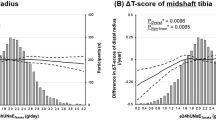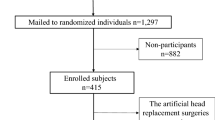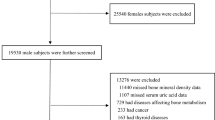Abstract
Background/Objectives:
High salt intake is a well-recognized risk factor of osteoporosis for its modulating effect on calcium metabolism. To understand the effect of dietary sodium on bone turnover, we evaluated the association between urinary sodium excretion and bone turnover markers in Korean postmenopausal women with low bone mass.
Subjects/Methods:
A retrospective review of medical records at a single institution identified 537 postmenopausal women who were first diagnosed with osteopenia or osteoporosis between 2008 and 2013. Subjects were stratified by low (<2 g/day, n=77), moderate (2–4.4 g/day, n=354) and high (⩾4.4 g/day, n=106) sodium excretion. A 24-h urine was collected to estimate sodium, calcium and creatinine. Bone turnover markers and calciotropic hormones were measured in serum. Bone mineral density (BMD) was assessed using dual-energy X-ray absorptiometry.
Results:
Sodium intake was positively associated with urinary sodium excretion (P=0.006, r=0.29). Bone turnover markers were significantly higher in the moderate-to-high urinary sodium excretion group (⩾2 g/day) than in the low urinary sodium excretion group (<2 g/day); CTX-I (C-telopeptides of type I collagen) was 21.3% higher (P=0.001) and osteocalcin (OC) was 15.7% higher (P=0.004). Calciotropic hormones and BMD were not significantly different across the sodium excretion groups.
Conclusions:
High urinary sodium excretion (⩾2 g/day) increased bone turnover markers in Korean postmenopausal women, suggesting that excessive sodium intake might accelerate bone turnover.
This is a preview of subscription content, access via your institution
Access options
Subscribe to this journal
Receive 12 print issues and online access
$259.00 per year
only $21.58 per issue
Buy this article
- Purchase on Springer Link
- Instant access to full article PDF
Prices may be subject to local taxes which are calculated during checkout


Similar content being viewed by others
References
Ministry of Health & Welfare, Korea Centers for Disease Control and Prevention Korea Health Statistics 2011: Korea National Health and Nutrition Examination Survey (KNHANES V-2). Korea Centers for Disease Control and Prevention: Seoul, Korea, 2012.
Guideline: Sodium Intake for Adults and Children. World Health Organization: Geneva, Switzerland, 2012.
Ministry of Health & Welfare, Korea Centers for Disease Control and Prevention Korea Health Statistics 2009: Korea National Health and Nutrition Examination Survey (KNHANES IV-3). Korea Centers for Disease Control and Prevention: Seoul, Korea, 2010.
Centers for Disease Control and Prevention Osteoporosis or low bone mass at the femur neck or lumbar spine in older adults: United States, 2005–2008 [cited by 2014 May 10]. Available from http://www.cdc.gov/nchs/data/databriefs/db93.htm.
Centers for Disease Control and Prevention Healthy people 2010 final review. Arthritis, osteoporosis, and chronic back conditions (accessed on 10 May 2014). Available from www.cdc.gov/nchs/data/hpdata2010/hp2010_final_review_focus_area_02.pdf.
Wade SW, Strader C, Fitzpatrick LA, Anthony MS, O'Malley CD . Estimating prevalence of osteoporosis: examples from industrialized countries. Arch Osteoporos 2014; 9: 182.
Dawson-Hughes B, Harris SS, Krall EA, Dallal GE . Effect of calcium and vitamin D supplementation on bone density in men and women 65 years of age or older. N Engl J Med 1997; 337: 670–676.
Dawson-Hughes B . Calcium and vitamin D nutritional needs of elderly women. J Nutr 1996; 126: 1165S–1167S.
Teucher B, Dainty JR, Spinks CA, Majsak-Newman G, Berry DJ, Hoogewerff JA et al. Sodium and bone health: impact of moderately high and low salt intakes on calcium metabolism in postmenopausal women. J Bone Miner Res 2008; 23: 1477–1485.
Zarkadas M, Gougeon-Reyburn R, Marliss EB, Block E, Alton-Mackey M . Sodium chloride supplementation and urinary calcium excretion in postmenopausal women. Am J Clin Nutr 1989; 50: 1088–1094.
Dawson-Hughes B, Fowler SE, Dalsky G, Gallagher C . Sodium excretion influences calcium homeostasis in elderly men and women. J Nutr 1996; 126: 2107–2112.
Nordin BE, Need AG, Morris HA, Horowitz M . The nature and significance of the relationship between urinary sodium and urinary calcium in women. J Nutr 1993; 123: 1615–1622.
Devine A, Criddle RA, Dick IM, Kerr DA, Prince RL . A longitudinal study of the effect of sodium and calcium intakes on regional bone density in postmenopausal women. Am J Clin Nutr 1995; 62: 740–745.
Lin PH, Ginty F, Appel LJ, Aickin M, Bohannon A, Garnero P et al. The DASH diet and sodium reduction improve markers of bone turnover and calcium metabolism in adults. J Nutr 2003; 133: 3130–3136.
Carbone LD, Barrow KD, Bush AJ, Boatright MD, Michelson JA, Pitts KA et al. Effects of a low sodium diet on bone metabolism. J Bone Miner Metab 2005; 23: 506–513.
Ministry of Health & Welfare, Korea Centers for Disease Control and Prevention Korea Health Statistics 2007: Korea National Health and Nutrition Examination Survey (KNHANES IV-1). Korea Centers for Disease Control and Prevention: Seoul, Korea, 2008.
Garnero P, Sornay-Rendu E, Chapuy MC, Delmas PD . Increased bone turnover in late postmenopausal women is a major determinant of osteoporosis. J Bone Miner Res 1996; 11: 337–349.
Garnero P, Mulleman D, Munoz F, Sornay-Rendu E, Delmas PD . Long-term variability of markers of bone turnover in postmenopausal women and implications for their clinical use: the OFELY study. J Bone Miner Res 2003; 18: 1789–1794.
Chaki O, Yoshikata I, Kikuchi R, Nakayama M, Uchiyama Y, Hirahara F et al. The predictive value of biochemical markers of bone turnover for bone mineral density in postmenopausal Japanese women. J Bone Miner Res 2000; 15: 1537–1544.
Centers for Disease Control and Prevention (CDC). Sodium intake among adults - United States, 2005-2006. MMWR Morb Mortal Wkly Rep 2010; 59: 746–749.
Powles J, Fahimi S, Micha R, Khatibzadeh S, Shi P, Ezzati M et al. Global, regional and national sodium intakes in 1990 and 2010: a systematic analysis of 24 h urinary sodium excretion and dietary surveys worldwide. BMJ Open 2013; 3: e003733.
Whelton PK, Appel LJ, Sacco RL, Anderson CA, Antman EM, Campbell N et al. Sodium, blood pressure, and cardiovascular disease: further evidence supporting the American Heart Association sodium reduction recommendations. Circulation 2012; 126: 2880–2889.
Kotchen TA, Cowley AW Jr, Frohlich ED . Salt in health and disease—a delicate balance. N Engl J Med 2013; 368: 1229–1237.
Audran M, Legrand E . Hypercalciuria. Joint Bone Spine 2000; 67: 509–515.
Sabto J, Powell MJ, Breidahl MJ, Gurr FW . Influence of urinary sodium on calcium excretion in normal individuals. A redefinition of hypercalciuria. Med J Aust 1984; 140: 354–356.
Jones G, Beard T, Parameswaran V, Greenaway T, von Witt R . A population-based study of the relationship between salt intake, bone resorption and bone mass. Eur J Clin Nutr 1997; 51: 561–565.
Shortt C, Madden A, Flynn A, Morrissey PA . Influence of dietary sodium intake on urinary calcium excretion in selected Irish individuals. Eur J Clin Nutr 1988; 42: 595–603.
Ross PD, Knowlton W . Rapid bone loss is associated with increased levels of biochemical markers. J Bone Miner Res 1998; 13: 297–302.
Gerdhem P, Ivaska KK, Alatalo SL, Halleen JM, Hellman J, Isaksson A et al. Biochemical markers of bone metabolism and prediction of fracture in elderly women. J Bone Miner Res 2004; 19: 386–393.
Garnero P . Markers of bone turnover for the prediction of fracture risk. Osteoporos Int 2000; 11: S55–S65.
Johnell O, Oden A, De Laet C, Garnero P, Delmas PD, Kanis JA . Biochemical indices of bone turnover and the assessment of fracture probability. Osteoporos Int 2002; 13: 523–526.
Vasikaran S, Eastell R, Bruyere O, Foldes AJ, Garnero P, Griesmacher A et al. Markers of bone turnover for the prediction of fracture risk and monitoring of osteoporosis treatment: a need for international reference standards. Osteoporos Int 2011; 22: 391–420.
Hochberg MC, Greenspan S, Wasnich RD, Miller P, Thompson DE, Ross PD . Changes in bone density and turnover explain the reductions in incidence of nonvertebral fractures that occur during treatment with antiresorptive agents. J Clin Endocrinol Metab 2002; 87: 1586–1592.
Delmas PD, Seeman E . Changes in bone mineral density explain little of the reduction in vertebral or nonvertebral fracture risk with anti-resorptive therapy. Bone 2004; 34: 599–604.
Biver E, Chopin F, Coiffier G, Brentano TF, Bouvard B, Garnero P et al. Bone turnover markers for osteoporotic status assessment? A systematic review of their diagnosis value at baseline in osteoporosis. Joint Bone Spine 2012; 79: 20–25.
Szulc P, Delmas PD . Biochemical markers of bone turnover: potential use in the investigation and management of postmenopausal osteoporosis. Osteoporos Int 2008; 19: 1683–1704.
Garnero P, Hausherr E, Chapuy MC, Marcelli C, Grandjean H, Muller C et al. Markers of bone resorption predict hip fracture in elderly women: the EPIDOS Prospective Study. J Bone Miner Res 1996; 11: 1531–1538.
van Daele PL, Seibel MJ, Burger H, Hofman A, Grobbee DE, van Leeuwen JP et al. Case-control analysis of bone resorption markers, disability, and hip fracture risk: the Rotterdam study. BMJ 1996; 312: 482–483.
Akesson K, Ljunghall S, Jonsson B, Sernbo I, Johnell O, Gardsell P et al. Assessment of biochemical markers of bone metabolism in relation to the occurrence of fracture: a retrospective and prospective population-based study of women. J Bone Miner Res 1995; 10: 1823–1829.
Szulc P, Chapuy MC, Meunier PJ, Delmas PD . Serum undercarboxylated osteocalcin is a marker of the risk of hip fracture: a three year follow-up study. Bone 1996; 18: 487–488.
Zemel MB, Bedford BA, Standley PR, Sowers JR . Saline infusion causes rapid increase in parathyroid hormone and intracellular calcium levels. Am J Hypertens 1989; 2: 185–187.
Breslau NA, McGuire JL, Zerwekh JE, Pak CY . The role of dietary sodium on renal excretion and intestinal absorption of calcium and on vitamin D metabolism. J Clin Endocrinol Metab 1982; 55: 369–373.
Jacobs MJ, Breslau PJ, Greep JM, Lemmens HA . Clinical and rheological studies in patients with intermittent claudication. Atherosclerosis 1985; 55: 331–337.
McParland BE, Goulding A, Campbell AJ . Dietary salt affects biochemical markers of resorption and formation of bone in elderly women. BMJ 1989; 299: 834–835.
Prince R, Devine A, Dick I, Criddle A, Kerr D, Kent N et al. The effects of calcium supplementation (milk powder or tablets) and exercise on bone density in postmenopausal women. J Bone Miner Res 1995; 10: 1068–1075.
Pattanaungkul S, Riggs BL, Yergey AL, Vieira NE, O'Fallon WM, Khosla S . Relationship of intestinal calcium absorption to 1,25-dihydroxyvitamin D [1,25(OH)2D] levels in young versus elderly women: evidence for age-related intestinal resistance to 1,25(OH)2D action. J Clin Endocrinol Metab 2000; 85: 4023–4027.
Heaney RP, Recker RR, Stegman MR, Moy AJ . Calcium absorption in women: relationships to calcium intake, estrogen status, and age. J Bone Miner Res 1989; 4: 469–475.
Massey LK, Whiting SJ . Dietary salt, urinary calcium, and bone loss. J Bone Miner Res 1996; 11: 731–736.
Author information
Authors and Affiliations
Corresponding author
Ethics declarations
Competing interests
The authors declare no conflict of interest.
Rights and permissions
About this article
Cite this article
Park, S., Joung, J., Cho, Y. et al. Effect of high dietary sodium on bone turnover markers and urinary calcium excretion in Korean postmenopausal women with low bone mass. Eur J Clin Nutr 69, 361–366 (2015). https://doi.org/10.1038/ejcn.2014.284
Received:
Revised:
Accepted:
Published:
Issue Date:
DOI: https://doi.org/10.1038/ejcn.2014.284
This article is cited by
-
Spironolactone reduces biochemical markers of bone turnover in postmenopausal women with primary aldosteronism
Endocrine (2020)
-
High dietary sodium intake is associated with low bone mass in postmenopausal women: Korea National Health and Nutrition Examination Survey, 2008–2011
Osteoporosis International (2017)
-
Adherence to the 2006 American Heart Association’s Diet and Lifestyle Recommendations for cardiovascular disease risk reduction is associated with bone mineral density in older Chinese
Osteoporosis International (2017)



